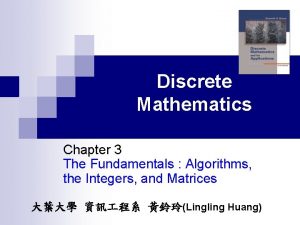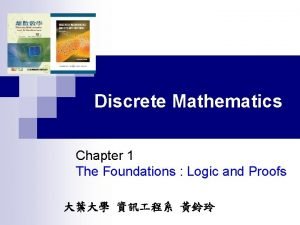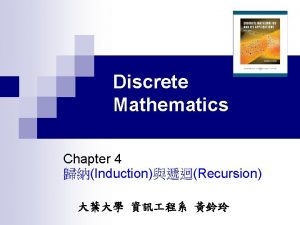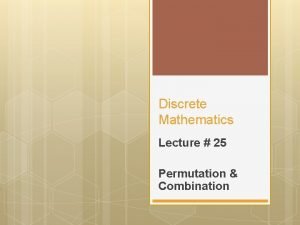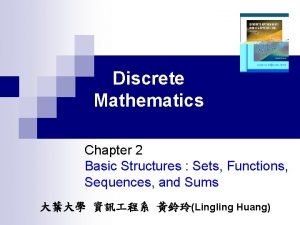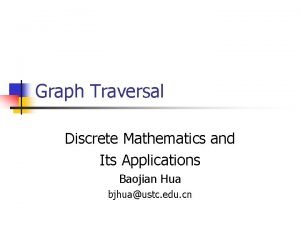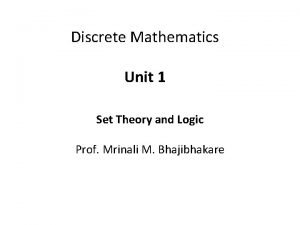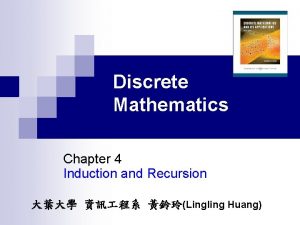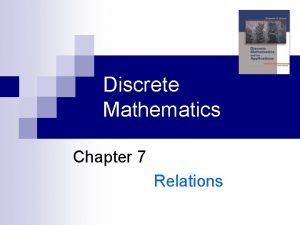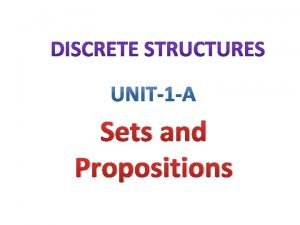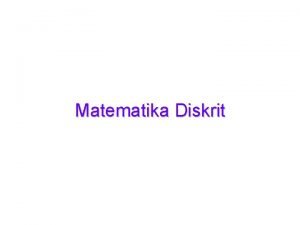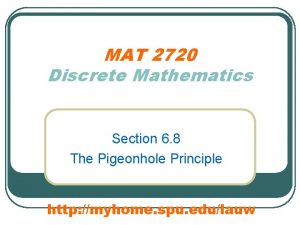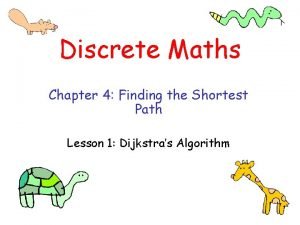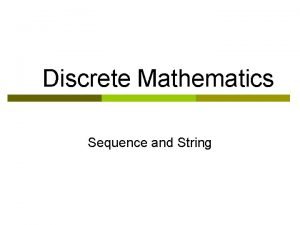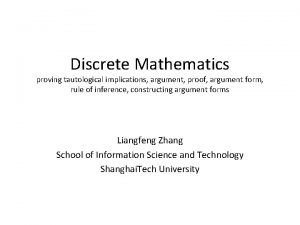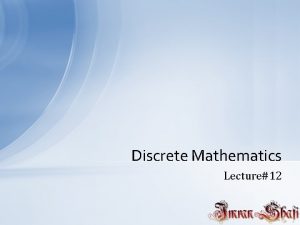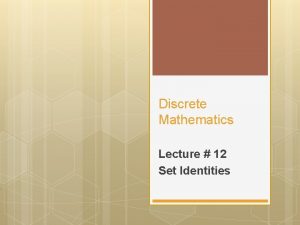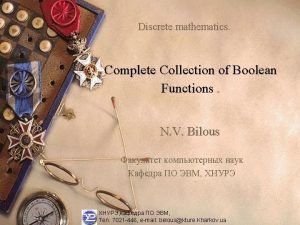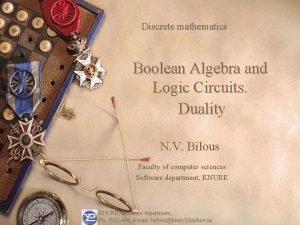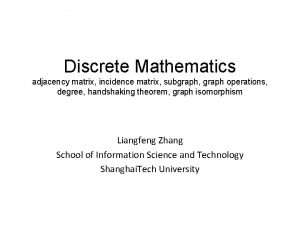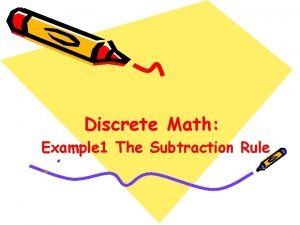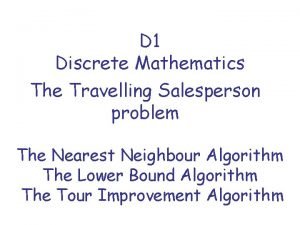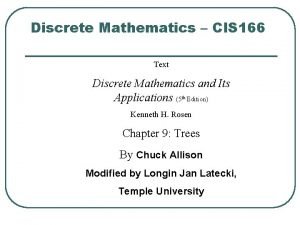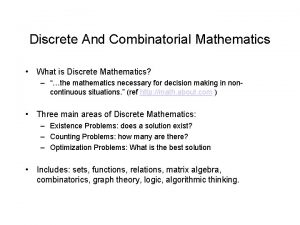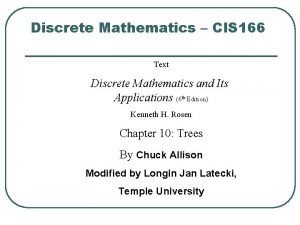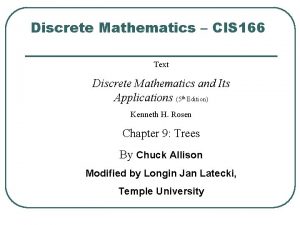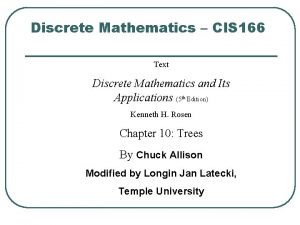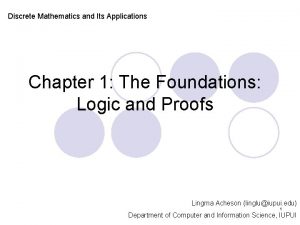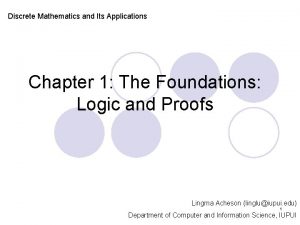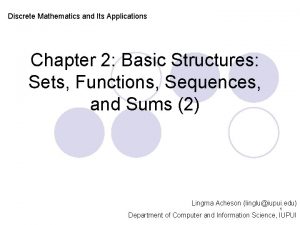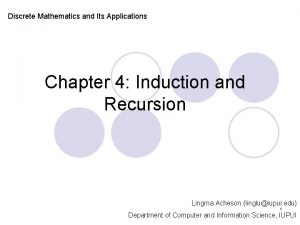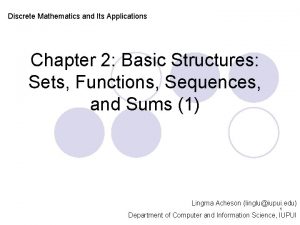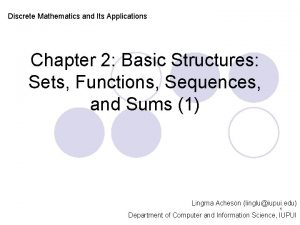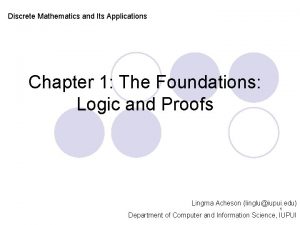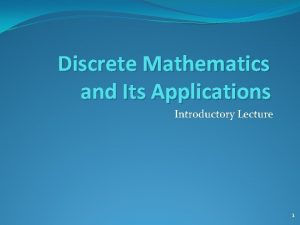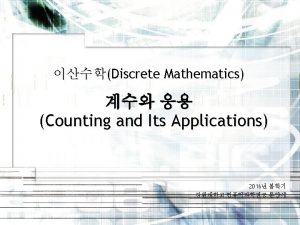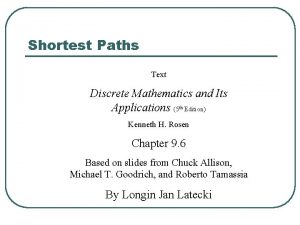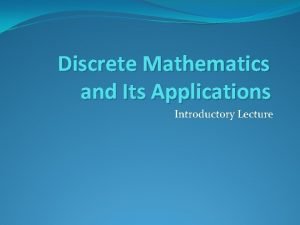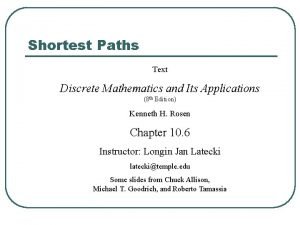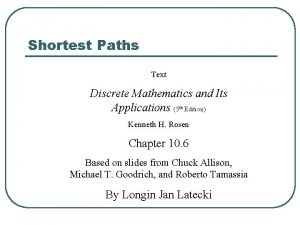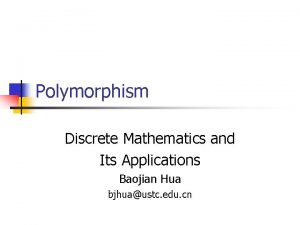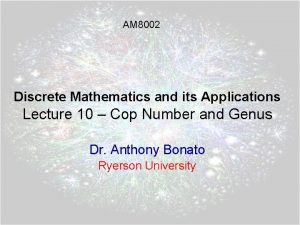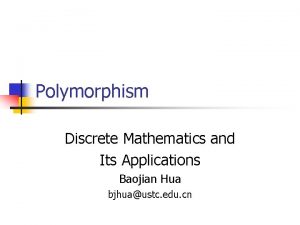Discrete Mathematics and Its Applications Chapter 3 The




















![3. 8 Matrices Matrix Arithmetic DEFINITION 3: Let A = [aij] and B = 3. 8 Matrices Matrix Arithmetic DEFINITION 3: Let A = [aij] and B =](https://slidetodoc.com/presentation_image/39f5d64f7fc894d20165ee43d7d16eb7/image-21.jpg)




![3. 8 Matrices DEFINITION 6: Let A = [aij] be an m x n 3. 8 Matrices DEFINITION 6: Let A = [aij] be an m x n](https://slidetodoc.com/presentation_image/39f5d64f7fc894d20165ee43d7d16eb7/image-26.jpg)

- Slides: 27

Discrete Mathematics and Its Applications Chapter 3: The Fundamentals: Algorithms, the Integers, and Matrices Lingma Acheson (linglu@iupui. edu) 1 Department of Computer and Information Science, IUPUI

3. 1 Algorithms Introduction l Algorithm: a procedure that follows a sequence of steps that leads to the desired answer. DEFINITION 1 An algorithm is a finite set of precise instructions for performing a computation or for solving a problem. l Example: Describe an algorithm for finding the maximum (largest) value in a finite sequence of integers. Solution: 1. Set the temporary maximum equal to the first integer in the sequence. (The temporary maximum will be the largest integer examined at any stage of the procedure. ) 2. Compare the next integer in the sequence to the temporary maximum, and if it is larger than the temporary maximum, set the temporary maximum equal to this integer. 3. Repeat the previous step if there are more integers in the sequence. 2 4. Stop when there are no integers in the sequence. The temporary maximum at this point is the largest integer in the sequence.

3. 1 Algorithms l An algorithm can also be described using pseudocode, an intermediate step between an English language description of an algorithm and an implementation of this algorithm in a programming language. l Having a pseudocode description of the algorithm is the starting point of writing a computer program. ALGORITHM 1: Finding the Maximum Element in a Finite Sequence. procedure max(a 1, a 2, …, an: integers) max: = a 1 for i: = 2 to n if max < ai, then max: = ai {max is the largest element} 3

3. 1 Algorithms l Several properties algorithms generally share: ¡ Input – An algorithm has input values from a specified set. ¡ Output – From each set of input values an algorithm produces output values from a specified set. The output values are the solution to the problems. ¡ Definiteness – The steps of an algorithm must be defined precisely. ¡ Correctness – An algorithm should produce the correct output values for each set of input values. ¡ Finiteness – An algorithm should produce the desired output after a finite (but perhaps large) number of steps for any input in the set. ¡ Effectiveness – It must be possible to perform each step of an algorithm exactly and in a finite amount of time. ¡ Generality – The procedure should be applicable for all problems of the desired form, not just for a particular set of input values. 4

3. 1 Algorithms Searching Algorithms l Locating an element x in a list of distinct elements a 1, a 2, …, an, or determine that it is not in the list. l E. g. search for a word in a dictionary find a student’s ID in a database table determine if a substring appears in a string l The linear search (sequential search) ¡ Begins by comparing x and a 1. When x = a 1, the solution is the location of a 1, namely, 1. When x ≠ a 1, compare x with a 2. If x = a 2, the solution is the location of a 2, namely, 2. When x ≠ a 2, compare x with a 3. Continue this process, comparing x successively with each term of the list until a match is found, where the solution is the location of the term. If the entire list has been searched without locating x, the solution is 0. ALGORITHM 2: The Linear Search Algorithm. procedure linear search(x: integer, a 1, a 2, …, an: distinct integers) i: = 1 While (i: <= n and x ≠ ai) i : = i + 1 If i <= n then location : = i else location : = 0 {location is the subscript of the term that equals x, or is 0 if x is not found} 5

3. 1 Algorithms l The binary search ¡ The algorithm is used when the list has terms occuring in order of increasing size (e. g. smallest to largest for numbers; alphabetic order for words). ¡ It proceeds by comparing the element to be located to the middle terms of the list. The list is then split into two smaller sublists of the same size, or where one of these smaller lists has one fewer term than the other. The search continues by restricting the search to the appropriate sublist based on the comparison of the element to be located and the middle term. ¡ Example: To search for 19 in the list 1 2 3 5 6 7 8 10 12 13 15 16 18 19 20 22 split the list into half – 1 2 3 5 6 7 8 10 12 13 15 16 18 19 20 22 Compare 19 with the largest term in the first list, 10 < 19, split the second half – 12 13 15 16 18 19 20 22 16 < 19, split the second half – 18 19 20 22 19 !< 19, split the first half – 18 19 18 < 19, use the second half, only one element, compare, get the location 6

3. 1 Algorithms ALGORITHM 3: The Binary Search Algorithm. procedure binary search (x: integer, a 1, a 2, …, an: increasing integers) i: = 1 {i is left endpoint of search interval} j: = n {j is right endpoint of search interval} while i < j begin m: = If x > am then i : = m + 1 else j : = m end if x = ai then location: = i else location: = 0 {location is the subscript of the term that equals x, or is 0 if x is not found} 7

3. 1 Algorithms Sorting l Putting the elements into a list in which the elements are in increasing order l The Bubble Sort ¡ It puts a list into increasing order by successively comparing adjacent elements, interchanging them if they are in the wrong order. The smaller elements “bubble” to the top as they are interchanged with larger elements and the larger elements “sink” to the bottom. ¡ Example: Use the bubble sort to put 3, 2, 4, 1, 5 into increasing order. First pass 3 2 2 3 4 4 1 1 5 5 Third pass 2 1 1 2 3 3 4 4 5 5 2 3 4 1 5 2 3 1 4 5 second pass 2 2 3 3 1 1 4 4 5 5 Fourth Pass 1 2 3 4 5 2 1 3 4 5 8

3. 1 Algorithms ALGORITHM 4: The Bubble Sort. procedure bubblesort(a 1, a 2, …, an: real numbers with n >=2) for i: = 1 to n – 1 for j: = 1 to n - i if aj > aj+1 then interchange aj and aj+1 {a 1, a 2, …, an is in increasing order} 9

3. 1 Algorithms l The Insertion Sort ¡ To sort a list with n elements, the insertion sort begins with the second element. The insertion sort compare this second element with the first element and inserts it before the first element if it does not exceed the first element and after the first element if it exceeds the first element. At this point, the first two elements are in the correct order. The third element is then compared with the first element, and if it is larger than the first element, it is compared with the second element; it is then inserted into the correct position among the first three elements. ¡ In general, in the jth step of the insertion sort, the jth element of the list is inserted into the correct position in the list of the previously sorted j -1 elements. ¡ Example: 3, 2, 1, 4, 5 10

3. 1 Algorithms ALGORITHM 5: The Insertion Sort. procedure insertion sort(a 1, a 2, …, an: real numbers with n >=2) for j: = 2 to n begin i: = 1 while aj > ai i : = i + 1 m : = aj for k: = 0 to j – i -1 aj-k = aj-k-1 ai : = m end {a 1, a 2, …, an are sorted} 11

3. 6 Integers and Algorithms Representation of Integers l Integers can be represented in decimal, binary, octal(base 8) or hexadecimal(base 16) notations. THEOREM 1: Let b be a positive integer greater than 1. Then if n is a positive integer, it can be expressed uniquely in the form n = akbk + ak-1 bk-1 + … + a 1 b + a 0 where k is a nonnegative integer, a 0, a 1, …, ak are nonnegative integers less than b, and ak ≠ 0. l Example: (965)10 = 9 * 102 + 6*101 + 5*100 (1 0101 1111)2 = 1*28 + 0*27 + 1*26 + … + 1*21 + 1*20 = (351)10 12

3. 6 Integers and Algorithms l Hexadecimal digits: 0, 1, 2, 3, 4, 5, 6, 7, 8, 9, A, B, C, D, E, F (16 digits or letters representing 0 – 15) l Example: (2 AE 0 B)16 = 2*164 + 10*163 + 14*162 + 0*161 + 11*160 = (175627)10 l Convert an integer from base 10 to base b: Divide n by b to obtain a quotient and a remainder. The remainder is the rightmost digit in the result. Keep dividing the quotient, and write down the remainder, until obtaining a quotient equal to zero. l Example: convert (12345)10 to base 8: 12345 = 8*1543 + 1 1543 = 8*192 + 7 192 = 8*24 + 0 24 = 8*3 + 0 3 = 8*0 + 3 (12345)10 = (30071)8 13

3. 6 Integers and Algorithms l Example: Find the hexadecimal expansion of (177130)10: 177130 = 16*11070 + 10 11070 = 16*691 + 14 691 = 16*43 + 3 43 = 16*2 + 11 2 = 16*0 + 2 (177130)10 = (2 B 3 EA)16 Find the binary expansion of (241)10: 14

3. 6 Integers and Algorithms for Integer Operations l Example: Add a = (1110)2 and b = (1011)2 1110 1011 ----------11001 l Algorithm: The binary expansion of a and b are: a = (an-1 an-2…a 1 a 0)2 b = (bn-1 bn-2…b 1 b 0)2 a and b each have n bits (putting bits equal to 0 at the beginning of one of these expansions if necessary). To add a and b, first add their rightmost bits. This gives a 0 + b 0 = c 0*2 + s 0 where s 0 is the rightmost bit and c 0 is the carry. Then add the next pair of bits and the carry, a 1 + b 1 + c 0 = c 1*2 + s 1 where s 1 is the next bit from the right. Continue the process. At the last stage, add an-1, bn-1 and cn-2 to obtain cn-1*2 + sn -1. The leading bit of the sum is sn=cn-1. 15

3. 6 Integers and Algorithms l Example: Following the procedure specified in the algorithm to add a = (1110)2 and b = (1011)2 a 0 + b 0 = 0 + 1 = 0*2 + 1 (c 0 = 0, s 0 = 1) a 1 + b 1 + c 0 = 1 + 0 = 1*2 + 0 (c 1=1, s 1 = 0) a 2 + b 2 + c 1 = 1 + 0 + 1 = 1*2 + 0 (c 2=1, s 2 = 0) a 3 + b 3 + c 2 = 1 + 1 = 1*2 + 1 (c 3=1, s 3 = 1) (s 4= c 3=1) result: 11001 16

3. 6 Integers and Algorithms l Example: Find the product of a = (110)2 and b = (101)2 110 101 ----------110 000 110 ----------11110 l Algorithm: ab = a(b 020 + b 121 + … + bn-12 n-1) = a(b 020) + a(b 121) + a(bn-12 n-1) Each time we mulply a term by 2, we shift its binary expansion one place to the left and add a zero at the tail end. Consequently we obtain (abj)2 j by shifting the binary expansion of abj j places to the left, adding j zero bits at the tail end. Finally we obtain ab by adding the n integers abj 2 j, j = 0, 1, 2, …, n-1 17

3. 6 Integers and Algorithms l Example: Find the product of a = (110)2 and b = (101)2 ab 020 = (110)2 *1 *20 = (110)2 ab 121 = (110)2 *0 *21 = (0000)2 ab 222 = (110)2 *1*22 = (11000)2 ab = (110)2 + (0000)2 + (11000)2 = (11110)2 18

3. 8 Matrices Introduction DEFINITION 1: A matrix is a rectangular array of numbers. A matrix with m rows and n columns is called an m x n matrix. The plural of matrix is matrices. A matrix with the same number of rows as columns is called square. Two matrices are equal if they have the same number of rows and the same number of columns and the corresponding entries in every position are equal. l Example: The matrix is a 3 x 2 matrix. 19

3. 8 Matrices DEFINITION 2: Let A= The ith row of A is the 1 x n matrix [ai 1, ai 2, …, ain]. The jth column of A is then n x 1 matrix The (i, j)th element or entry of A is the element aij, that is, the number in the ith row and jth column of A. A convenient shorthand notation for expressing the matrix A is to write A = [aij], which indicates that A is the matrix with its (i, j)th element equal to aij. 20
![3 8 Matrices Matrix Arithmetic DEFINITION 3 Let A aij and B 3. 8 Matrices Matrix Arithmetic DEFINITION 3: Let A = [aij] and B =](https://slidetodoc.com/presentation_image/39f5d64f7fc894d20165ee43d7d16eb7/image-21.jpg)
3. 8 Matrices Matrix Arithmetic DEFINITION 3: Let A = [aij] and B = [bij] be m x n matrices. The sum of A and B, denoted by A + B, is the m x n matrix that has aij + bij as its (i, j)th element. In other words, A + B = [aij + bij]. l The sum of two matrices of the same size is obtained by adding elements in the corresponding positions. l Matrices of different sizes cannot be added. l Example: 21

3. 8 Matrices DEFINITION 4: Let A be an m x k matrix and B be a k x n matrix. The product of A and B, denoted by AB, is the m x n matrix with its (i, j)th entry equal to the sum of the products of the corresponding elements from the ith row of A and the jth column of B. In other words, if AB = [cij], then cij = ai 1 b 1 j + ai 2 b 2 j + … + aikbkj. l The product of the two matrices is not defined when the number of columns in the first matrix and the number of rows in the second matrix is not the same. l Example: Let A = and B = Find AB if it is defined. AB = 22

3. 8 Matrices l If A and B are two matrices, it is not necessarily true that AB and BA are the same. E. g. if A is 2 x 3 and B is 3 x 4, then AB is defined and is 2 x 4, but BA is not defined. l Even when A and B are both n x n matrices, AB and BA are not necessarily equal. l Example: Let A = and B = Does AB = BA? Solution: AB = and BA = 23

3. 8 Matrices ALGORITHM 1: Matrix Multiplication. procedure matrix multiplication(A, B: matrices) for i: = 1 to m for j: = 1 to n begin cij : =0 for q: = 1 to k cij : = cij + aiqbqj end {C=[cij ] is the product of A and B} 24

3. 8 Matrices Transposes and Powers of Matrices DEFINITION 5: The identity matrix of order n is the n x n matrix Ιn = [ ], where = 0 if i ≠ j. Hence =1 if i = j and Ιn = l Multiplying a matrix by an appropriately sized identity matrix does not change this matrix. In other words, when A is an m x n matrix, we have AIn= Im. A = A l Powers of square matrices can be defined. When A is an n x n matrix, we have l A 0 = In, Ar = AAAA…A (r times) 25
![3 8 Matrices DEFINITION 6 Let A aij be an m x n 3. 8 Matrices DEFINITION 6: Let A = [aij] be an m x n](https://slidetodoc.com/presentation_image/39f5d64f7fc894d20165ee43d7d16eb7/image-26.jpg)
3. 8 Matrices DEFINITION 6: Let A = [aij] be an m x n matrix. The transpose of A, denoted by At, is the n x m matrix obtained by interchanging the rows and columns of A. In other words, if At = [bij], then bij = aji, for i = 1, 2, …, n and j = 1, 2, …, m. l Example: The transpose of the matrix is the matrix 26

3. 8 Matrices DEFINITION 7: A square matrix A is called symmetric is A = At. Thus A = [aij] is symmetric if aij = aji for all i and j with 1 <= i <= n and 1 <= j <= n. l Example: The matrix is symmetric. 27
 Application of propositional logic
Application of propositional logic Susanna s epp
Susanna s epp The value of 52003 mod 7 is?
The value of 52003 mod 7 is? Mathematical system examples
Mathematical system examples Discrete mathematics chapter 1
Discrete mathematics chapter 1 Discrete mathematics chapter 1
Discrete mathematics chapter 1 Permutation and combination in discrete mathematics
Permutation and combination in discrete mathematics Sets and functions in discrete mathematics
Sets and functions in discrete mathematics Dfs in discrete mathematics
Dfs in discrete mathematics Discrete mathematics
Discrete mathematics Induction and recursion discrete mathematics
Induction and recursion discrete mathematics Antisymmetric relation
Antisymmetric relation Sets and propositions
Sets and propositions Matematika diskrit kenneth rosen pdf
Matematika diskrit kenneth rosen pdf Pigeonhole principle in discrete mathematics
Pigeonhole principle in discrete mathematics Discrete structures
Discrete structures Kesetaraan logis
Kesetaraan logis Shortest path in discrete mathematics
Shortest path in discrete mathematics Discrete math sequences
Discrete math sequences Tautological implications in discrete mathematics
Tautological implications in discrete mathematics Define inverse relation
Define inverse relation Set identities exercises
Set identities exercises Boolean function in discrete mathematics
Boolean function in discrete mathematics Advanced counting techniques in discrete mathematics
Advanced counting techniques in discrete mathematics Duality principle in discrete mathematics
Duality principle in discrete mathematics Incidence matrix in discrete mathematics
Incidence matrix in discrete mathematics Subtraction rule in discrete mathematics
Subtraction rule in discrete mathematics Travelling salesman problem in discrete mathematics
Travelling salesman problem in discrete mathematics


